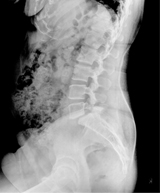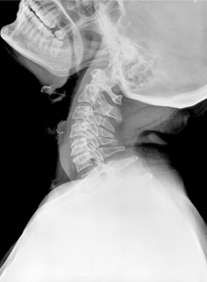
Spondylosis of the spine can affect any of the joints in the lumbar region of the vertebrae which provide support for the spine. The vertebrae consists of individual bones which are joined together by discs which absorb shock, allow movement and provide cushioning.
The major weight bearing area of the body is the lumbar region. Degenerative disease like spondylosis (spinal osteoarthritis) can compromise the structural integrity of the spine affecting multiple joints. This is accompanied by overgrowth of bone and the formation of bone spurs.
In ayurveda the conditions which can result in backpain include external traumatic factors (abhighataja), and internal (nija)
Lower back (kadi) is a vata specific site, at the same time joints are site of sleshaka sleshma(kapha), due to the causes(nidanas) vatha aggravation occur in kapha sthana, and due to the increased ruksha guna(quality of dryness,leading to reduction in water content resulting in prolapse and inturn nerve irritation .
The aim of the treatment is to reduce the dryness and bring back the sneha guna, elasticity and to rehydrate the disc, removing the osteophytes also called the mala roopa kapha. The treatment will be mainly vataharam and kaphaharam in initial stages and brmhanam in later stages to nourish the disc.
The Ayurvedic Slipped Disc treatment can be divided into following stages.
Meditation and Medication for two to three months while orally taking traditional Ayurvedic herbal medicines
This Herbal medicine strengthens the Nervous System and specifically the Para-Vertebral muscles of the back. By this it reduces the compression on the Inter-Vertebral Disc and gives relief to all the related symptoms.
Effects on the spine of external influences like concussion, hypertension, hyper flexion, etc.
Cervical Spondylosis (neck pain),vertigo,ulnar nerve palsies

Neck pain is one of the most common problems that one encounters in day to day life. Cervical spondylosis is a ‘wear and tear’ of the vertebrae and discs in the neck Cervical spondylosis may be caused by one or more of several complaints. Degenerative osteoarthiritis of the joints between the central of the spinal vertebrae or neural foraminae, it may cause pressure on nerve roots sensory and motor disturbances including pain, muscle weakness in the limbs. When the space between two adjacent vertebrae narrows, compression of a nerve root emerging from the spinal cord may result in radiculopathy ( severe pain in the neck, shoulder, arm, back, or leg, accompanied by muscle weakness) and sometimes loss of balance.
Between each vertebrae is an intervertebral disc which acts like a shock absorber and allows flexibility of the spine. Muscles and ligaments run between, and are attached to, the vertebrae. Nerves from the spinal cord pass between the vertebrae going to the shoulder, neck, arm, and upper chest. With the increase in number of workers who sit for hours together doing desk work or sitting for hours in front of the computer and even in call center jobs which requires continuous sitting in one posture, the number of people suffering with cervical spondylosis is increased in such a way that in every ten IT professionals one will be having these complaints.
Symptoms
Causes
Diagnosis
Bone region or asthi is vata site in Ayurveda and at the same time joints are site of sleshaka kapha, because of the causes vata aggrevation occurs in kapha sthanam and due to the increase in ruksha guna (quality of dryness) the dehydration OF DISC GET STARTED, making the sclerotic changes and in later part bulging, herniation prolapse and degeneration.
Herbal medicine strengthens the Nervous System and specifically the Para-spinal muscles of the neck. By this, it reduces the compression on the Inter-Vertebral Disc and gives relief to all the related symptoms
Surgery may be necessary if you have severe pain that does not improve from other treatments. It should be your last resort as there is always a risk factor involved.
FUSION – which surgically joins bones in the spine, making them rigid – or artificial material to replace the defective discs. In some cases, these methods cause further degeneration of the disc above and below the area are most affected.
Effective treatment modality for tenniselbow,carpel tunnel syndrome (CTS),trigger finger without surgery Our own special..............